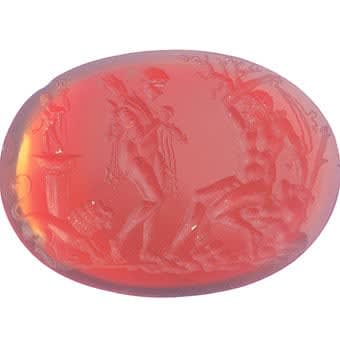Classical Revival Intaglio of Herakles & Omphale, 18th Century CE
Carnelian
1.5
FJ.6550
The art of glyptics, or carving on colored precious stones, is probably one of the oldest known to humanity. Intaglios, gems with an incised design, were made as early as...
The art of glyptics, or carving on colored precious stones, is probably one of the oldest known to humanity. Intaglios, gems with an incised design, were made as early as the fourth and third millennia B.C. in Mesopotamia and the Aegean Islands. They exhibit a virtuosity of execution that suggests an old and stable tradition rooted in the earliest centuries. The tools required for carving gems were simple: a wheel with a belt-drive and a set of drills. A special difficulty of engraving intaglios, aside from their miniature size, was that the master had to work with a mirror-image in mind.
The Classical Revival was a phenomenon that swept through Europe in the 18th and 19th Centuries. A new appreciation for antiquity and ancient art forms was fostered by discoveries in the nascent scientific field of archaeology. Perhaps the Classical Revival also reveals a latent longing towards the Arcadian lifestyles of yesterday abandoned as Europe became rapidly industrialized and increasingly urbanized. Engraved upon the polished surface of this precious gemstone is a depiction of a the great hero Herakles and the Queen of Lydia Omphale. There are different versions of this myth, one has it that Herakles had to enter into the service of the queen for a period of three years in order to atone for his many murders. The other legend states that Herakles visited Lydia while undertaking one of his twelve labors only to become so intoxicate that the Queen took advantage of him. Either way, both tales end with Omphale wearing Herakles’ lion skin and brandishing his club while the great hero performed the duty of women. This stunning intaglio seems to depict the moment Herakles awakes from his drunken stupor to discover the Queen has borrowed his belongings. This story of role reversal reveals that the ancients had a keen sense of humor even when it came to their favorite heros.
The Classical Revival was a phenomenon that swept through Europe in the 18th and 19th Centuries. A new appreciation for antiquity and ancient art forms was fostered by discoveries in the nascent scientific field of archaeology. Perhaps the Classical Revival also reveals a latent longing towards the Arcadian lifestyles of yesterday abandoned as Europe became rapidly industrialized and increasingly urbanized. Engraved upon the polished surface of this precious gemstone is a depiction of a the great hero Herakles and the Queen of Lydia Omphale. There are different versions of this myth, one has it that Herakles had to enter into the service of the queen for a period of three years in order to atone for his many murders. The other legend states that Herakles visited Lydia while undertaking one of his twelve labors only to become so intoxicate that the Queen took advantage of him. Either way, both tales end with Omphale wearing Herakles’ lion skin and brandishing his club while the great hero performed the duty of women. This stunning intaglio seems to depict the moment Herakles awakes from his drunken stupor to discover the Queen has borrowed his belongings. This story of role reversal reveals that the ancients had a keen sense of humor even when it came to their favorite heros.
